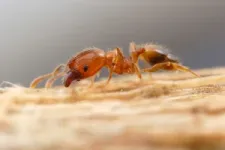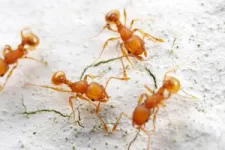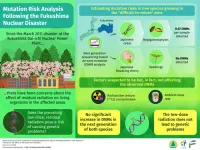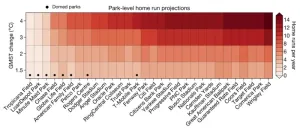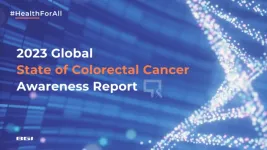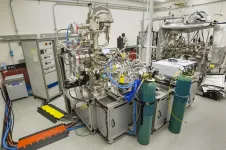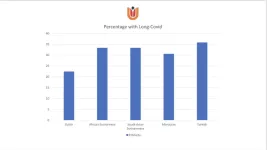How to make electronic noses smell better
A comprehensive review of methods and algorithms
2023-04-07
(Press-News.org)
Imagine if you could ask a machine to “smell” something for you with just a click of a button. That’s what electronic noses, or e-noses, are for. They are systems that combine chemical gas sensors, signal processing and machine learning algorithms to mimic the sense of smell. E-noses can be used for many purposes, such as checking food quality, monitoring air pollution, diagnosing diseases and detecting explosives. How do they work? What are the challenges and opportunities in this field? A team led by Jingdong Chen of Northwestern Polytechnical University in Xi’an, China and Weiwei Wu of Xidian University in Xi’an, China have recently explored these questions in a comprehensive review of the methods and algorithms developed for e-noses. The review discusses the limitations of current gas sensors and provides an outlook on algorithm design.
The review was published Jan. 20 in Intelligent Computing, a Science Partner Journal.
E-noses artificially mimic the biological sense of smell. The gas sensors of the e-noses correspond to biological olfactory receptor neurons. When you sniff something, tiny molecules float through the air and enter your nose. Similarly, a gas sensor can capture airborne molecules through an air intake system. The sensor reacts to these molecules and changes in a way that can be measured by electronic signals. These signals are then converted from an analog format to a digital format so that computers can use algorithms to analyze and interpret the data.
The review summarizes existing methods and algorithms in the field of e-noses, grouping them according to a classification framework that highlights the challenges presented by the following limitations of gas sensors:
Limitations on selectivity. When exposed to an odorant mixture, gas sensors respond to all stimuli in the mixture, making it difficult to distinguish different odors. They may also be affected by nontarget odors, and different sensors may respond differently to the same chemical stimulus.
Limitations on sensitivity. Every gas sensor operates within a range defined by the minimum and maximum quantity it is able to detect. Some are more sensitive than others, but the range of a particular sensor is not always known. Sensors also vary in their ability to accurately detect odor concentration.
Limitations on stability. Gas sensors often do not produce a stable and reproducible response to the same chemical stimuli due to material aging, environmental changes or sensor failure.
Limitations on reproducibility. Two gas sensors of the same type may have different responses to the same gas under the same conditions.
Limitations on noise. Gas sensors are affected by external and internal noise. Sources of external noise include background odor variation, turbulence of airflow and changes in temperature, humidity and pressure in the surrounding environment. Internal noise consists of noise generated by the measurement circuits and the sensors themselves.
Despite the significant progress made in the last few decades, the large-scale deployment of e-noses in practical applications still has a long way to go.
The authors of the review believe that ensuring the robustness of e-nose systems should be a top priority for future research and development. While odor identification and intensity quantification have been widely investigated, there are several crucial tasks that demand greater attention. These include interference suppression and recognition, optimization of sensor arrays, detection of sensor drift and failure, noise reduction and utilization, and determining the limit of detection, among others. In addition, they say it is important to delve into the fundamental mathematical model of the sensing mechanisms, which is the foundation for solving many issues related to e-noses.
The authors of the paper are Taoping Liu, Chen Su and Weiwei Wu of Xidian University, Xi’an, China, Lihua Guo, Mou Wang and Jingdong Chen of Northwestern Polytechnical University, Xi’an, China and Di Wang and Hao Dong of Zhejiang Lab, Hangzhou, China.
This work was supported in part by the Open Fund of the State Key Laboratory of Optoelectronic Materials and Technologies (Sun Yat-sen University), the Open Fund of Zhejiang Lab, the Fundamental Research Funds for the Central Universities, and Key Research and Development Program of Shaanxi.
END
ELSE PRESS RELEASES FROM THIS DATE:
2023-04-07
Ionizing radiation from nuclear disasters are known to be harmful to the natural environment. The Fukushima Dai-ichi Nuclear Power Plant meltdown that occurred in 2011 is a prominent example of such a disaster in recent memory. Even a decade after the incident, concerns remain about the long-term effects of the radiation. In particular, it is not clear how the residual low-dose radiation might affect living organisms at the genetic level.
The brunt of the disaster is usually borne by the floras inhabiting the contaminated areas since they cannot move. This, however, makes them ideal for ...
2023-04-07
A team led by Masaya Hagiwara of RIKEN national science institute in Japan has developed an ingenious device, using layers of hydrogels in a cube-like structure, that allows researchers to construct complex 3D organoids without using elaborate techniques. The group also recently demonstrated the ability to use the device to build organoids that faithfully reproduce the asymmetric genetic expression that characterizes the actual development of organisms. The device has the potential to revolutionize the way we test drugs, and could also provide insights into how tissues develop and lead to ...
2023-04-07
Dan Răzvan Popoviciu new book New Worlds: Colonizing Planets, Moons and Beyond (published by Bentham Science) explores the possibilities of transforming humanity into a multi-planetary species, while also sounding an alarm about our long-term future. It emphasizes the importance of efficiently using Earth's resources and expanding beyond the planet's borders.
In the book, Popoviciu discusses how various planets, moons, and asteroids in the Solar System can provide important resources and become potential new home worlds for humans. The author goes beyond simple colonization and discusses solutions for terraforming ...
2023-04-07
In the history of Major League Baseball, first came the low-scoring dead-ball era, followed by the modern live-ball era characterized by power hitters such as Babe Ruth and Henry "Hank" Aaron. Then, regrettably, was the steroid era of the 1990s and early 2000s.
Now, could baseball be on the cusp of a "climate-ball" era where higher temperatures due to global warming increasingly determine the outcome of a game?
A new Dartmouth College study suggests it may be. A report in the Bulletin of the ...
2023-04-07
To uncover attitudes and the biggest challenges facing colorectal cancer (CRC) awareness and screening, BGI Genomics today released its State of Colorectal Cancer Awareness Report, marking the first-ever global survey report on the world's third most common cancer. This report is released on World Health Day, April 07, 2023, in line with achieving Health For All, and seeks to motivate action to tackle the health challenges of today and tomorrow.
This ...
2023-04-07
Two Smidt Heart Institute experts have been honored for their contributions to medical research by being inducted into select medical societies, while a third expert has been selected for a leadership position.
Cardiologist, echocardiographer and clinician-scientist Susan Cheng, MD, director of Cardiovascular Population Sciences in the Smidt Heart Institute and the Erika J. Glazer Chair in Women’s Cardiovascular Health and Population Science, has been elected to the American Society for Clinical Investigation (ASCI) Council. ASCI is regarded as the most prestigious ...
2023-04-07
People around the globe are so dependent on the internet to exercise socio-economic human rights such as education, healthcare, work, and housing that online access must now be considered a basic human right, a new study reveals.
Particularly in developing countries, internet access can make the difference between people receiving an education, staying healthy, finding a home, and securing employment – or not.
Even if people have offline opportunities, such as accessing social security schemes or finding housing, they are at a comparative ...
2023-04-07
UPTON, NY— Researchers at Binghamton University led research partnering with the Center for Functional Nanomaterials (CFN)—a U.S. Department of Energy (DOE) Office of Science User Facility at Brookhaven National Laboratory—to get a better look at how peroxides on the surface of copper oxide promote the oxidation of hydrogen but inhibit the oxidation of carbon monoxide, allowing them to steer oxidation reactions. They were able to observe these quick changes with two complimentary spectroscopy ...
2023-04-07
New research led by the University of East Anglia (UEA) suggests a way to greatly improve the outcomes of biodiversity conservation efforts globally.
Scientists from UEA, the RSPB and Natural England, propose that biodiversity auditing should be integral to the ongoing development of regionally-targeted conservation plans, such as the Local Nature Recovery Strategies (LNRS) established by the UK Environment Act 2021.
It follows work conducted with two conservation projects in the East of England - one in North Norfolk and another in the Brecks - using this approach to guide conservation locally.
A biodiversity ...
2023-04-07
All prominent migrant groups in the Netherlands are suffering more from long-covid than the native Dutch population, research from Amsterdam UMC has found. The study, published today, in The Lancet Regional Health – Europe, shows that in some groups the rates of long-covid are up to 50% larger than in the Dutch population. Resulting in many migrant groups “suffering in silence,” in the words of senior author Professor Charles Agyemang.
COVID-19 has had a devastating impact on vulnerable communities, particularly people from ethnic minorities and migrant backgrounds. Research from Amsterdam UMC already found that these populations ...
LAST 30 PRESS RELEASES:
[Press-News.org] How to make electronic noses smell better
A comprehensive review of methods and algorithms

